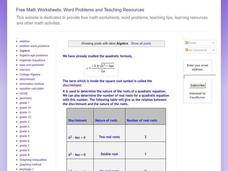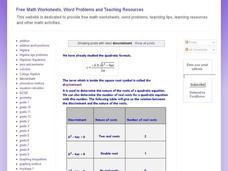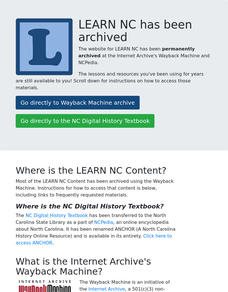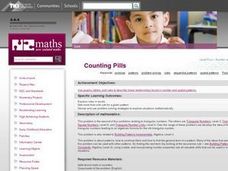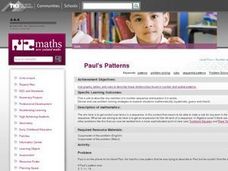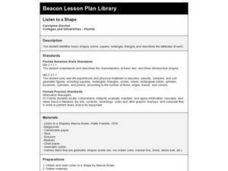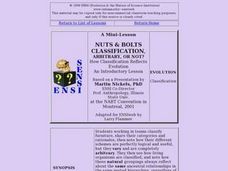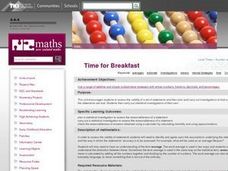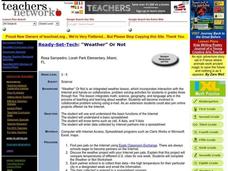Curated OER
Square and Triangular Numbers
Young scholars use equations to represent practical situations. They solve linear equations and quadratic equations. The use of problem solving strategies is also developed.
Curated OER
Quadratic equations
In this Algebra II worksheet, 11th graders use the quadratic formula to solve quadratic equations. The interactive lesson contains explanation and worked examples with five practice problems. Answers are not included.
Curated OER
Discriminant and Quadratics
In this quadratic equation, students find the discriminant using the formula given and identify how many solutions a quadratic function will have. There are 3 problems with answers and examples.
Curated OER
Quadratic Equations
In this Algebra I/Algebra II worksheet, students investigate the various methods that can be used to solve quadratic equations. The one page interactive worksheet contains instruction, worked examples and five practice...
Curated OER
Solving Quadratic Equations
In this Algebra II worksheet, 11th graders use the quadratic formula to solve quadratic equations. The six page worksheet contains instruction on topic, worked examples and five practice problems. Answers are not provided.
Curated OER
Quadratic Formula
In this Algebra II activity, 11th graders use the discriminant to determine the nature of the roots of a quadratic equation, determine the best method to use when solving a quadratic, and practice using the quadratic formula to determine...
Curated OER
Supermarket Displays
Second graders look at the number patterns created when cans are stacked in different arrangements. The aim of the unit is for students to keep track of the numbers involved by drawing up a table of values. They are then encouraged to...
Curated OER
The Cuisenaire Four-Pan Algebra Balance: Limitations and Suggestions
Young scholars illustrate the concept of balancing equations using a Four-Pan Algebra Balance. In this balancing lesson, students visualize why it is necessary to add or subtract the same quantity on both sides of an equation when...
Curated OER
What Makes a Dog a Dog
First graders recall and verbally list the parts of a dog, or a chosen subject, based on observations using the senses. They discriminate between living and non-living subjects, and create artistic representations of the parts of a dog.
Curated OER
Tallying Animals
Second graders draw a picture of a pond scene which includes various animals. They exchange pictures and tally the number of animals drawn. Then they record the number on a chart and write a story about their pictures.
Curated OER
Counting Pills
Young scholars are introduced to the problem. They brainstorm ideas for approaching the problem and keeping track of what has been done. Students work on the problem in pairs to discover what strategies might help to find the answer.
Curated OER
Paul's Patterns
Fourth graders listen to the problem. As the students work ask them questions that require them to describe the patterns in their own words.
If the students are having problems with finding the patterns encourage them to explore the...
Curated OER
Our Favorite Pet
Students each have a turn, telling the class his or her favorite pet. The choices are cat, dog, fish or bird. Using the computer, the information from the tally be recorded on a spreadsheet and bar graph.
Curated OER
Listen to a Shape
First graders identify basic shapes (circle, square, rectangle, triangle) and describes the attributes of each. They use magazines to find examples of each shape, and then make a collage.
Curated OER
Nuts & Bolts: is Classification, Arbitrary, Or Not?
Students, in groups, classify furniture, share their categories and rationales, then note how their different schemes vary, perfectly logical and useful, but completely arbitrary.
Curated OER
Time For Breakfast
This unit encourages students to assess the validity of a set of statements and then plan and carry out investigations to find out whether the statements are true. Students then carry out statistical investigations of their own.
Curated OER
Taxi Fare
Students discuss what they know about taxis and how they charge. They read the problem and work in pairs focusing their thinking on the repeating pattern of twos. They then share their solutions and conclude with some class practice...
Curated OER
Spheres
High schoolers work algebraic expressions with various types of powers to find the solutions. They Students also become familiar with problems that involve the square roots of numbers. The work should be completed with computational...
Curated OER
Telling Time: Hours
Students participate in a discussion about the different types of timepieces and the energy sources necessary to run them. They observe the numbers on a clock and review the hands and what they mean and make individual clocks using a...
Curated OER
Unit Circle Triangle
Students find the different ratios of a right triangle. In this geometry lesson, students apply the concept of the Pythagorean theorem as they identify the different angles and parts of a Unit Circle. They find the ratios of sine,...
Curated OER
Weather Or Not
Students use the internet to find pen pals to share in their weather experiment. Individually, they research the high and low temperatures for cities within the United States and email the results to their pen pal. They also develop a...
Curated OER
Forces Applied to an Object
Fourth graders predict, observe, and compare what happens when a force is applied to an object. In this forces lesson, 4th graders complete a 'swinging hammer' activity to learn about forces and motion.
Curated OER
How Does Radon Get Into Your Home?
Students examine their home and calculates the amount of ventilation found. They also compute the surface area of different objects. They determine what is needed to reduce the amount of radon entering the home.
Curated OER
How Does Radon Get Into Your Home?
Students complete an experiment in which they measure the radon level in their home. They examine the different types of units of measurement and practice using them throughout the activity. They calculate surface area on objects as well.

